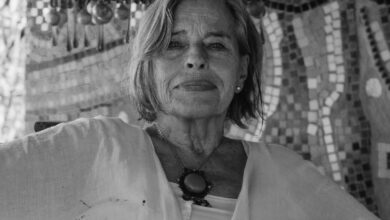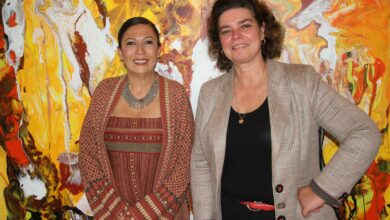Dazzling creatures like green ogresses, oversized genies, and elongated animals swarm the dreamy universe of Adel El Siwi, a painter who seems firmly in touch with his childhood imagination. In his paintings, El Siwi’s subconscious pours its magic on to large canvases that become world’s haunted by mythological beasts and patient human faces.
Adel El Siwi’s magical work is currently being shown at an exhibition at Horizon One Gallery in Giza. The show is a powerful aesthetic experience that invites the viewer to become immersed into the painter’s imaginary world.
“For the past three years I have attempted to narrate a fable that recounts itself and unravels instantaneously,” writes El Siwi as an introduction to the coffee table book Adel El Siwi 2010, a retrospective of his latest paintings.
“The Fable of the Monkey and the Gazelle” is one of the first paintings the viewer sees when entering the Horizon One Gallery and it captures the overall ambiance well. Against a sand-yellow background, steppe animals–a tapered gazelle, a pensive elongated heron, a pheasant, a couple of monkeys–parade. The painting evokes a feeling similar to that of a faded dream. Some details are accurate and vivid, others fade upon waking up and are gone forever.
“Night stars” immerses the viewer into a universe of lake spirits under a starry sky. The painting depicts a man sitting in a bark on a still lake at night. A vivid green ogress smiles at him. The man is just a black shadow, and only the brim of his fedora gleams under the stars. The enormous, deformed female body seems to be gently rocking his bark to lull him.
A few steps down the hall, a painting attracts the viewer with its shape and its subject. “Abu El Seoud” is a large, round painting that follows the same imaginative thread by depicting a massive genie crouching with a large clay pot clutched in his arms. A thick golden earring dangles from his ear and his hazel eyes quietly observe the cacti that grow in miniature clay pots all around him and on his dark skin. This painting is an ode to fertility and plenitude, characteristics rarely represented by a male character.
“Solitude” is one of the most disturbing paintings in the exhibition. A mythological beast that is a combination of a human, a gazelle and a peacock walks against a yellow background. The human-like head and neck, which fade into a gazelle-like body, are stained with black spots and the countenance is blank and haggard. The body, which looks like it belongs to a corpse, ends with black and white fluffy peacock feathers which fall down, reinforcing the air of despair.
El Siwi seems fascinated by the aesthetic of the Pharaonic era and repeatedly paints portraits of people with unmistakably ancient Egyptian features. The bald, shining head, the high forehead, the proud expression of the almond eyes, the thick lips, and the elongated face clearly reflect the ancient Egyptian kings.
The painter, in a series representing ancient Egyptian characters, Africans, and animals, uses a palette of gold, white, black and brown to achieve his radical technique of fragmented scenes.
At the end of the gallery, running along a black wall, is a series of ten portraits called “Girls and their Mothers.” In black and white, with occasional touches of brown, these paintings portray African women in diptychs. The painter, who seized on the similarity in spirit between mother and daughter, also stresses their differences. The daughters’ bodies are blossoming. They proudly exhibit their curves to the painter, while the mothers share an air of calm and resignation.
Adel El Siwi, through this dream-like exhibition, proves once more his exuberant talent and his ability to transport the viewer into his mythical universe.
The exhibition runs until 17 February at the Horizon One Gallery in the Mahmud Mokthar Museum. 1 Kafour St., Giza, near the Orman Post Office. 10 AM to 9 PM, Saturday through Thursday.




